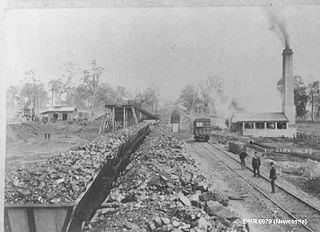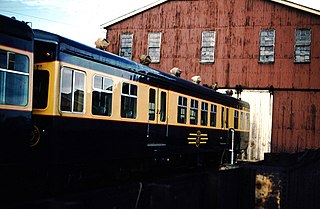
Hexham is a suburb of the city of Newcastle, about 15 km (9 mi) inland from the Newcastle CBD in New South Wales, Australia on the bank of the Hunter River.

Cessnock is a city in the Hunter Region of New South Wales, Australia, about 52 km (32 mi) by road west of Newcastle. It is the administrative centre of the City of Cessnock LGA and was named after an 1826 grant of land called Cessnock Estate, which was owned by John Campbell. The local area was once known as "The Coalfields", and it is the gateway city to the vineyards of the Hunter Valley, which includes Pokolbin, Mount View, Lovedale, Broke, Rothbury, and Branxton.
The Rhymney Railway was a railway company in South Wales, founded to transport minerals and materials to and from collieries and ironworks in the Rhymney Valley of South Wales, and to docks in Cardiff. It opened a main line in 1858, and a limited passenger service was operated in addition.

Maitland railway station is located on the Main Northern line in New South Wales, Australia. It serves the city of Maitland opening on in 1880 as West Maitland being renamed on 1 April 1949. It is the junction station for the Main Northern and North Coast lines. It was added to the New South Wales State Heritage Register on 2 April 1999.
George Booth was an Australian politician, elected as a member of the New South Wales Legislative Assembly.
The South Maitland coalfields was the most extensive coalfield in New South Wales until the great coal mining slump of the 1960s. It was discovered by Lieutenant-Colonel Paterson's party when they were engaged in an exploratory visit to the Hunter River Valley during July 1801.

Kurri Kurri is a small town in the Hunter Region of New South Wales, Australia, in the Cessnock LGA. At the 2016 census, its population was 6,044. Kurri Kurri is the largest town in a group of towns and hamlets, including Stanford Merthyr, Pelaw Main, Weston, Abermain and Heddon Greta, called Kurri Kurri – Weston by the ABS. Its estimated population was 17,241 at 2016 census.
Newcastle bus routes connect suburbs in and around Newcastle and Lake Macquarie, about 100 kilometres north of Sydney.

The South Maitland Railway was once an extensive network of privately owned colliery and passenger railway lines which served the South Maitland coalfields in the Hunter Region of New South Wales, Australia and were the second last system in Australia to use steam haulage, having used steam locomotives until 1983.

The Richmond Vale Railway was a 4 ft 8 1⁄2 in colliery railway line in the Hunter Region of New South Wales, Australia, servicing coal mines at Minmi, Stockrington, Pelaw Main and Richmond Main. It was over 26 km (16 mi) long and passed through three tunnels, and was the last commercially operated railway in Australia to use steam locomotives.
The Llancaiach Branch railway line was a mineral branch line in Glamorganshire, South Wales. It was authorised in 1836 as part of the Taff Vale Railway, and its purpose was to connect collieries at Llancaiach and bring their output to Cardiff for onward shipment. It was designed by Isambard Kingdom Brunel and built on the standard gauge. It opened in 1841 from a junction with the Merthyr line immediately south of Abercynon. It was intended to be horse worked, and included a self-acting rope-worked inclined plane near the junction. The collieries were slow to use the line, preferring their customary use of a tramroad and the Glamorganshire Canal, and the value of the line was diminished when the Taff Vale Extension line, an east-west connecting line belonging to the Newport, Abergavenny and Hereford Railway, intersected it and cut off the colliery connections, and the line became dormant.

The South Maitland Railways 10 Class locomotives is a class of 14 2-8-2T steam locomotives built for the East Greta Coal Company by Beyer, Peacock and Company in Manchester, England, between 1911 and 1925. Members of this class of locomotive were the last steam locomotives in commercial use in Australia.

Stanford Main No. 2 Colliery, also known as Paxton Colliery, was a coal mine located at Paxton, New South Wales, Australia. The mine was named Stanford Merthyr No. 2 until 1 May 1931. The mine was started in the 1920s, by the East Greta Coal Mining Company. The Greta coal seam has been mined using bord and pillar mining methods. Coal was transported from the mine via the Paxton Branch of the South Maitland Railway.
Hunter Valley Mining Locomotives (Australia) included the South Maitland Railways 10 Class which were ordered by SMR and built by Beyer Peacock. Beyer Peacock suggested a tank engine as it would be ready earlier and could go fast backwards as opposed to a tender engine which could not. They arrived between 1912 and 1925 with a total of 14 engines produced. These served alongside Richmond Vale Railway's ROD 2-8-0s and Kitsons, and New South Wales Government Railways locomotives. Also made by Beyer Peacock was the SMR 15 class which was a copy of the NSWGR 30 Class. Numbers 15 and 16 were built in 1912 and No 29 in 1923. These were initially used for passenger services but when that stopped they pulled coal for the rest of their lives. All were scrapped in late 1973. The Kitson locomotives were known on the Richmond Vale Railway as the 9-11 Class. Locomotives 9,10 and 11 were tank locomotives and had the appearance of a side tank version of an ROD 2-8-0. Numbers 9 and 10 ended their careers on the RVR's Hexham washery shunt and the short trip to Stockrington Colliery. No 9 was originally called Pelaw Main and 10 was called Richmond Main. No 11 was called Hexham. The ROD 2-8-0 Locomotives mentioned above were purchased by J&A Brown for Coal Haulage on their Richmond Vale Railway, 13 ROD Locomotives were purchased in all, three remain.

The Richmond Vale Railway Museum operates a railway and museum located at the heritage-listed Richmond Main Colliery south of Kurri Kurri, New South Wales. The museum is a volunteer non-profit organization, formed in 1979 with the aim of preserving the Richmond Vale railway line and the mining heritage of J & A Brown and the Hunter Valley.

Gillieston Heights is a suburb of the City of Maitland local government area in the Hunter Region of New South Wales, Australia, approximately 5.1 km (3.2 mi) from the Maitland CBD. Prior to 1967, the village was named East Greta however this was changed to honour former Maitland mayor and member of the New South Wales Legislative Assembly John Gillies following a poll of residents. At the 2016 census, Gillieston Heights had a population of over 3,000.
J & A Brown was an privately owned Australian coal family firm founded by James Brown (1816–1894) and Alexander Brown (1827–1877).

Richmond Main Colliery is a heritage-listed former coal mine and now open-air museum at South Maitland Coalfields, Kurri Kurri, City of Cessnock, New South Wales, Australia. It was designed by the staff at J & A Brown's Engineering Workshops at Hexham under the direction of John Brown and built from 1908 to 1913 by the J & A Brown Firm. The site now operates as the Richmond Main Heritage Park, including the Richmond Vale Railway Museum and Richmond Main Mining Museum. The property is owned by Cessnock City Council. It was added to the New South Wales State Heritage Register on 2 April 1999.

South Maitland Railway Workshops is a heritage-listed former railway workshops and now museum and industrial site at Junction Street, Telarah, City of Maitland, New South Wales, Australia. It was added to the New South Wales State Heritage Register on 2 April 1999.













